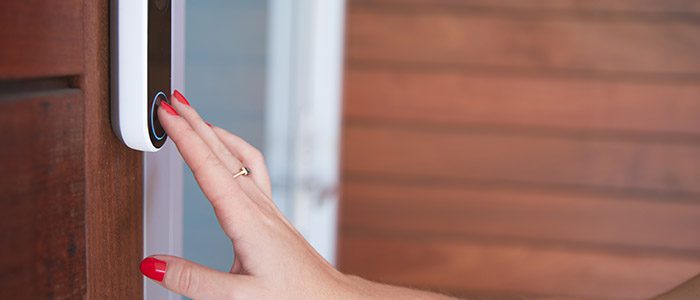
Doorbell & motion sensor cameras have become increasingly popular as a means of home security & monitoring. These cameras offer homeowners peace of mind, providing notifications & video footage of anyone who approaches their property. Despite their effectiveness, there can be instances where these cameras may not capture everything that occurs on your property. For instance, you may have experienced situations where you thought a service technician (like those from Consolidated Pest Control) didn’t show up, only to find out later that they indeed did but were not captured by your cameras. Understanding how these devices work & why they sometimes don’t detect activity can help alleviate concerns & ensure you’re getting the service you expect.
How Doorbell Cameras Work
Doorbell cameras, such as those from Ring, Nest, & other popular brands, typically work by using a combination of a built-in camera, a microphone, a speaker, & a motion sensor. When someone approaches your door, the motion sensor is triggered, causing the camera to start recording. Simultaneously, the system sends a notification to your smartphone or other connected devices, allowing you to see & communicate with the person at your door in real-time.
The Role of Motion Sensors
The motion sensor is a critical component of a doorbell camera. It detects movement within a predefined range & field of view. Most doorbell cameras use passive infrared (PIR) technology to detect heat signatures from living beings, such as people or animals. When the sensor detects a heat source moving within its range, it triggers the camera to start recording.
However, the effectiveness of motion sensors can be influenced by various factors, such as:
- Range & Field of View: The range of the motion sensor is limited. If a person approaches from outside this range, the camera may not detect their presence . Additionally, the sensor’s field of view is typically narrow, focusing only on a specific area in front of your door.
- Sensitivity Settings: Many doorbell cameras allow you to adjust the sensitivity of the motion sensor. If the sensitivity is set too low, the camera might not trigger for smaller movements or people who approach slowly. Conversely, setting it too high might cause the camera to trigger for insignificant movements, such as a tree branch swaying in the wind.
- Environmental Conditions: Weather conditions like extreme cold, heat, or heavy rain can affect the performance of PIR sensors. In some cases, they might fail to detect movement, or they might generate false alerts.
How Motion Sensor Cameras Work
In addition to doorbell cameras, many homeowners use standalone motion sensor cameras to monitor larger areas of their property. These cameras work similarly to doorbell cameras but often have a wider field of view & can be positioned in various locations around your home.
Like doorbell cameras, these devices also rely on PIR sensors to detect movement. However, because they are often used to monitor larger areas, they might have additional features, such as:
- Adjustable Mounting: These cameras can be mounted at different angles & heights to cover more ground. Proper placement is essential to ensure that the camera captures the areas you want to monitor.
- Zone Customization: Some cameras allow you to define specific zones within the camera’s field of view. You can customize these zones to focus on high-traffic areas or exclude areas where false alerts might occur, such as near trees or busy streets.
- Continuous Recording: Unlike doorbell cameras, which typically only record when motion is detected, some motion sensor cameras offer continuous recording. This ensures that you capture everything, even if the motion sensor fails to trigger.
Why Your Technician Might Not Trigger Your Camera
Now that you have a better understanding of how doorbell & motion sensor cameras work, let’s explore some reasons why a service technician from Consolidated Pest Control might not trigger your camera when they arrive at your property.
- Approaching from an Unmonitored Area
One of the most common reasons a technician might not trigger your camera is if they approach from an area that isn’t covered by your camera’s field of view. For instance, if your camera is positioned to monitor only the front door, but the technician enters through a side gate or walks along a path that is outside the camera’s range, the camera won’t detect their presence.
- Out of Range of the Motion Sensor
As mentioned earlier, motion sensors have a limited range . If the technician remains outside of this range while performing their work, the camera may not pick up any movement. This could happen if the technician is working in your yard, away from the main entry points where your cameras are typically focused.
- Motion Sensor Sensitivity Settings
If your camera’s motion sensor sensitivity is set too low, it might not trigger for certain movements, especially if the technician is moving slowly or carrying equipment that doesn’t generate a strong heat signature . Adjusting the sensitivity settings can help ensure that your camera picks up on more subtle movements.
- Environmental Factors
Environmental conditions can also play a role in whether or not your camera detects a technician’s presence . For example, extreme weather conditions, such as heavy rain or intense sunlight, might interfere with the motion sensor’s ability to detect movement. Additionally, if there are objects like trees or large vehicles blocking the sensor’s view, it might fail to trigger when someone is present.
- Camera Placement
The placement of your cameras is crucial to their effectiveness. If your camera is positioned too high, too low, or at an angle that doesn’t cover the area where the technician is working, it won’t detect their presence . Ensuring that your cameras are strategically placed to cover all entry points & areas of interest can help mitigate this issue.
- Power or Connectivity Issues
Finally, power or connectivity issues can also prevent your camera from functioning properly. If your camera loses power or its connection to your home’s Wi-Fi network, it won’t be able to record or send notifications. Regularly checking your camera’s status & ensuring that it’s properly connected can help prevent these issues.
Ensuring Peace of Mind
While doorbell & motion sensor cameras are valuable tools for home security & monitoring, they are not foolproof. Understanding how these devices work & the potential reasons why they might not capture every moment can help you better manage your expectations & ensure that you’re getting the service you expect.
If you’re concerned about whether a technician from Consolidated Pest Control has visited your property, it’s always a good idea to reach out to the company directly. They can provide confirmation of the visit & address any concerns you might have . Additionally, considering the placement & settings of your cameras can help you maximize their effectiveness & avoid any future confusion.
By taking these steps, you can continue to enjoy the benefits of your home security system while ensuring that your property receives the care & attention it needs.








